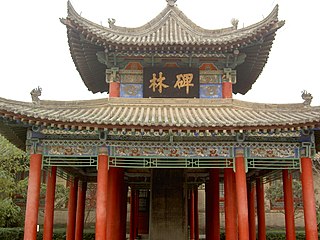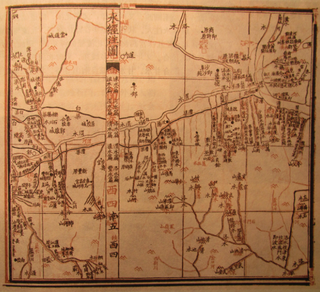- 1 2 "Yang Shoujing". Guoxue (in Chinese). 19 November 2005.
- 1 2 3 Brown (2012), p. 72.
- 1 2 3 4 Brown (2012), p. 73.
- ↑ Brown (2012), p. 74–75.
- ↑ National Palace Museum (1966), p. 98.
- 1 2 Yeh (2000), p. 35.
- ↑ Wilkinson (2015), p. 246.
- ↑ Wilkinson (2015), p. 245.
- 1 2 3 Brown (2012), p. 82.
- ↑ Brown (2012), p. 81.
- ↑ "在宜都追忆学者杨守敬". Hubei Daily (in Chinese). 14 March 2002.
Related Research Articles

Ink wash painting ; is a type of Chinese ink brush painting which uses washes of black ink, such as that used in East Asian calligraphy, in different concentrations. It emerged during the Tang dynasty of China (618–907), and overturned earlier, more realistic techniques. It is typically monochrome, using only shades of black, with a great emphasis on virtuoso brushwork and conveying the perceived "spirit" or "essence" of a subject over direct imitation. Ink wash painting flourished from the Song dynasty in China (960–1279) onwards, as well as in Japan after it was introduced by Zen Buddhist monks in the 14th century. Some Western scholars divide Chinese painting into three periods: times of representation, times of expression, and historical Oriental art. Chinese scholars have their own views which may be different; they believe that contemporary Chinese ink wash paintings are the pluralistic continuation of multiple historical traditions.

The Ming tombs are a collection of mausoleums built by the emperors of the Ming dynasty of China. The first Ming emperor's tomb is located near his capital Nanjing. However, the majority of the Ming tombs are located in a cluster near Beijing and collectively known as the Thirteen Tombs of the Ming dynasty. They are located within the suburban Changping District of Beijing Municipality, 42 kilometers (26 mi) north-northwest of Beijing's city center. The site, on the southern slope of Tianshou Mountain, was chosen based on the principles of feng shui by the third Ming emperor, the Yongle Emperor. After the construction of the Imperial Palace in 1420, the Yongle Emperor selected his burial site and created his own mausoleum. The subsequent emperors placed their tombs in the same valley.

The Stele Forest or Beilin Museum is a museum for steles and stone sculptures in Beilin District in Xi'an, Northwest China. The museum, which is housed in a former Confucian Temple, has housed a growing collection of Steles since 1087. By 1944 it was the principal museum for Shaanxi province. Due to the large number of steles, it was officially renamed the Forest of Stone Steles in 1992. Altogether, there are 3,000 steles in the museum, which is divided into seven exhibitions halls that display works of Chinese calligraphy, painting and historical records.

Zhu Da (朱耷), also known by his pen name Bada Shanren (八大山人), was a late-Ming and early-Qing dynasty Chinese painter, calligrapher, and poet. He was born in Nanchang, Jiangxi, in 1626, at during the Ming-Qing Transition. Zhu was mentally ill and displayed erratic behavior. He was related to the House of Zhu, which was destroyed and executed by the new Qing dynasty. Fearing that he would also be purged and executed, he fled to a Buddhist temple and learned the teachings of Chan (Zen) Buddhism, becoming a monk for 30 years.

Chinese calligraphy is the writing of Chinese characters as an art form, combining purely visual art and interpretation of the literary meaning. This type of expression has been widely practiced in China and has been generally held in high esteem across East Asia. Calligraphy is considered one of the four most-sought skills and hobbies of ancient Chinese literati, along with playing stringed musical instruments, the board game "Go", and painting. There are some general standardizations of the various styles of calligraphy in this tradition. Chinese calligraphy and ink and wash painting are closely related: they are accomplished using similar tools and techniques, and have a long history of shared artistry. Distinguishing features of Chinese painting and calligraphy include an emphasis on motion charged with dynamic life. According to Stanley-Baker, "Calligraphy is sheer life experienced through energy in motion that is registered as traces on silk or paper, with time and rhythm in shifting space its main ingredients." Calligraphy has also led to the development of many forms of art in China, including seal carving, ornate paperweights, and inkstones.

Yan Zhenqing was a Chinese calligrapher, military general, and politician. He was a leading Chinese calligrapher and a loyal governor of the Tang dynasty. His artistic accomplishment in Chinese calligraphy is equal to that of the greatest master calligraphers of history, and his regular script style, Yan, has often been imitated.
Imperial Tombs of the Ming and Qing Dynasties is the designation under which the UNESCO has included several tombs and burial complexes in the list of World Heritage Sites. These tombs date from the Ming and Qing dynasties of China.

The Commentary on the Water Classic, or Commentaries on the Water Classic, commonly known as Shui Jing Zhu, is a work on the Chinese geography in ancient times, describing the traditional understanding of its waterways and ancient canals, compiled by Li Daoyuan during the Northern Wei dynasty. The book is divided into sections by river, each described with its source, course, and major tributaries, including cultural and historical notes.

Ouyang Xun, courtesy name Xinben, was a Chinese calligrapher, politician, and writer of the early Tang dynasty. He was born in Hunan, Changsha, to a family of government officials; and died in modern Anhui province.

The Hall of Mental Cultivation is a building in the inner courtyard of the Forbidden City in Beijing, China. The hall is a wooden structure with dome coffered ceilings, and was first built during the Ming dynasty in 1537, and was reconstructed during the Qing dynasty. During the early Qing dynasty under the reign of the Kangxi Emperor the hall was mostly used as a workshop, wherein artisan objects like clocks were designed and manufactured. From the reign of the Yongzheng Emperor during the 18th century, the hall was the residence for the emperor. Under the reign of the Qianlong Emperor until the fall of the Qing dynasty, the hall became the centre of governance and political administration. In the Western Warmth Chamber, the emperor would hold private meetings, and discuss state affairs with his mandarins. After the death of Emperor Xianfeng, from inside the Eastern Warmth Chamber, empress dowagers Ci'an and Cixi would hold audiences with ministers and rule from behind a silk screen curtain during their regencies for emperors Tongzhi and Guangxu, who both succeeded to the throne as children in the second half of the 19th century.
The Historical Atlas of China is an 8-volume work published in Beijing between 1982 and 1988, edited by Tan Qixiang. It contains 304 maps and 70,000 placenames in total. The Concise Historical Atlas of China was published in 1991.
Yu Zhong, courtesy name Shifang, was an official in the state of Eastern Wu during the Three Kingdoms period of China.

Wang Xibang was a contemporary Chinese painter, calligrapher, poet, educator, and antique collector. Wang Xibang excelled in calligraphy and painting of plum blossom, pine, lotus, peony, wisteria, and loquat tree. He was the founder of Xin’an Association of Fine Arts, a member of the Chinese Artists Association, and a member of the Chinese Poet Association.
Xiong Huizhen was a Chinese historical geographer and a disciple of the late-Qing dynasty scholar Yang Shoujing. He is known for completing the Shui jing zhu shu, a monumental annotation of the 6th-century geographic classic Shui jing zhu.

Ming Dynasty is a 2019 Chinese television series giving a fictionalised account of the life of Empress Sun, who was an empress consort of the Xuande Emperor. Starring Tang Wei and Zhu Yawen, it aired on Hunan Television until 2020. Loosely adapted from the novel The Chronicle of the Six Eras by Lianjing Zhuyi, the show gained much attention and viewership from non-Chinese viewers after it achieved high ratings in mainland China.

Sun Yueh was a Taiwanese actor.
Dongwu was the era name (nianhao) of Zhu Changqing, Prince of Huai of the Southern Ming. It lasted for one year.
Miao Quansun, courtesy name Yanzhi, was a Chinese philologist, historian, educationalist, bibliographer and librarian. He oversaw the foundation of the Jiangnan Library in Nanjing and was the first administrator of the National Library of China in Beijing.
Handan Chun, courtesy name Zishu or Zili, also known as Handan Zhu, was a writer, calligrapher, and official from Yingchuan Commandery who served the state of Cao Wei during the early 3rd century. As a calligrapher, he was an expert in many types of scripts and was one of the first scholars to study the Shuowen Jiezi. He is credited with restoring the archaic tadpole script tradition. His most famous work is the Xiaolin (笑林), a collection of humorous anecdotes.

Ye Gongchuo was a Chinese politician, calligrapher, poet, and art patron. Born in Panyu County, Guangdong, to the family of a Qing dynasty official, Ye passed the imperial examination and joined the Ministry of Posts and Communications. He rose through the ministry rapidly, then allied himself with Sun Yat-sen's anti-Qing movement in the 1911 Revolution. During the first decades of the Republic of China, Ye occupied several ministerial positions as a member of the Communications Clique, at times working with the Beiyang government and other times siding with the Kuomintang.
References
- Brown, Shana J. (2012). "Modern Antiquarianism and Sino-Japanese Rivalry: Yang Shoujing in Meiji Japan". In Fogel, Joshua A. (ed.). Role of Japan in Modern Chinese Art. University of California Press. ISBN 978-0-520-28984-0.
- National Palace Museum (1966). Chinese Cultural Art Treasures: Illustrated Handbook. National Palace Museum.
- Wilkinson, Endymion (2015). Chinese History: A New Manual (fourth ed.). Harvard University Asia Center. ISBN 978-0-674-08846-7.
- Yeh, Wen-Hsin (2000). The Alienated Academy: Culture and Politics in Republican China, 1919-1937. Harvard University Asia Center. ISBN 978-0-674-00284-5.
Yang Shoujing | |||||||||
|---|---|---|---|---|---|---|---|---|---|
楊守敬 | |||||||||
 Yang Shoujing at age 75 | |||||||||
| Born | June 2, 1839[ citation needed ] | ||||||||
| Died | January 9, 1915 (aged 75) | ||||||||
| Occupation(s) | Antiquarian, bibliophile, calligrapher, diplomat, geographer, and historian | ||||||||
| Chinese name | |||||||||
| Traditional Chinese | 楊 守 敬 | ||||||||
| Simplified Chinese | 杨 守 敬 | ||||||||
| |||||||||
| International | |
|---|---|
| National | |
| Academics | |
| People | |